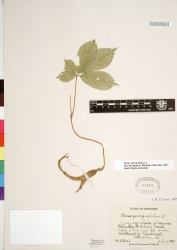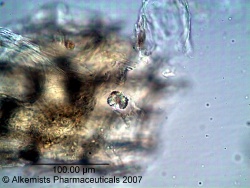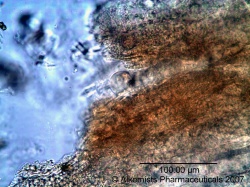Panax quinquefolius (root)
From AHPA Botanical Identity References Compendium
(Difference between revisions)
(add macro characteristics) |
|||
| (8 intermediate revisions by 3 users not shown) | |||
| Line 1: | Line 1: | ||
| − | + | {{DISPLAYTITLE:''Panax quinquefolius'' (root) }} {{askbox|herb=''Panax quinquefolius''}} | |
| − | '' | + | =Nomenclature= |
| + | {{nomenclature | binomial=Panax quinquefolius | ||
| + | |authority=L. | ||
| + | |family=Araliaceae | ||
| + | |scn=American ginseng | ||
| + | |syn= | ||
| + | |ayurvedic= | ||
| + | |pinyin=xi yang shen (root) | ||
| + | |aka= | ||
| + | |notes=}} | ||
| − | + | =Botanical Voucher Specimen= | |
| − | |||
| − | + | {{Media |cat=Voucher | |
| + | |||
| + | | source=MOBOT, Tropicos.org | ||
| + | | mainimage=Panax quinquefolius Tropicos 53111.jpg | ||
| + | | companyimage=TropicosLogo.gif | ||
| + | | companyURL=http://www.tropicos.org/Image/53111 | ||
| + | | reference=Tropicos.org. Missouri Botanical Garden. 19 Mar 2014 <http://www.tropicos.org/Image/53111> | ||
| − | + | | }} | |
| − | '' | + | =Organoleptic Characteristics= |
| − | = | + | {| border=1 |
| − | =Microscopic | + | | |
| − | {{Microscopy | source=Elan M. Sudberg, Alkemist Laboratories | + | {{Organolepsy | source=United States Dispensatory (1918) |
| + | | description=[''Panax ginseng'' (root)] has a feeble odor, and a sweet, slightly aromatic taste, somewhat analogous to that of licorice root.}} | ||
| + | |} | ||
| + | |||
| + | =Macroscopic Characteristics= | ||
| + | {| border=1 | ||
| + | | | ||
| + | {{Macroscopy | source=American Medicinal Plants of Commercial Importance (1930) | ||
| + | | description=Ginseng is an erect plant growing from 8 to 15 inches high and bearing three leaves at the summit, each leaf consisting of five thin, stalked leaflets. The three upper leaflets are larger than the two lower ones. From 6 to 20 greenish-yellow flowers are produced in a small cluster during July and August, followed later in the season by bright-crimson berries. Ginseng has a thick, fleshy, spindle-shaped root 2 to 3 inches or more in length and about one-half to 1 inch in thickness, often branched. After the second year the root becomes branched or forked. | ||
| + | }} | ||
| + | {{Macroscopy | source=United States Dispensatory (1918) | ||
| + | | description=The root is fleshy, somewhat spindle-shaped, from 5 to 12 cm. long, and 1 to 2.5 cm. thick, and terminated by one or more stem scars. Frequently there are two portions, sometimes three or more, connected at their upper extremity, and bearing a supposed, though very remote, resemblance to the human figure, from which circumstance it is said that the Chinese name ginseng originated. When dried, the root is yellowish-white and wrinkled externally, and within consists usually of a hard central portion, surrounded by a soft whitish bark. }} | ||
| + | |} | ||
| + | =Microscopic Characteristics= | ||
| + | |||
| + | {{Media2 |cat=Microscopy | source=Elan M. Sudberg, Alkemist Laboratories | ||
| companyimage= AP-LOGO-Laboratories Crop - Copy.jpg | | companyimage= AP-LOGO-Laboratories Crop - Copy.jpg | ||
| − | | companyURL=http://www. | + | | companyURL=http://www.alkemist.com |
| mainimage=American ginseng.jpg | | mainimage=American ginseng.jpg | ||
| caption1=Rosette of calcium oxalate observed at 400x with Acidified Chloral Hydrate Glycerol Solution. | | caption1=Rosette of calcium oxalate observed at 400x with Acidified Chloral Hydrate Glycerol Solution. | ||
| − | | | + | | source2=Elan M. Sudberg, Alkemist Laboratories |
| + | | companyimage2= AP-LOGO-Laboratories Crop - Copy.jpg | ||
| + | | companyURL2=http://www.alkemist.com | ||
| image2=American ginseng-1.jpg | | image2=American ginseng-1.jpg | ||
| caption2=Yellow secretion from a resin canal observed at 400x with Acidified Chloral Hydrate Glycerol Solution. | | caption2=Yellow secretion from a resin canal observed at 400x with Acidified Chloral Hydrate Glycerol Solution. | ||
| characteristics=cellular structures identified in this botanical specimen are the rosette of calcium oxalate and the yellow secretion from a resin canal when observed at 400x with Acidified Chloral Hydrate Glycerol Solution. | | characteristics=cellular structures identified in this botanical specimen are the rosette of calcium oxalate and the yellow secretion from a resin canal when observed at 400x with Acidified Chloral Hydrate Glycerol Solution. | ||
| + | | reference=Herbal Drugs and Phytopharmaceuticals, Max Wichtl, 3rd ed., 2004 | ||
| }} | | }} | ||
| − | = | + | =High Performance Thin Layer Chromatographic Identification= |
| − | = | + | |
| + | =Supplementary Information= | ||
| + | =Sources= | ||
| + | <references /> | ||
Latest revision as of 20:55, 16 June 2015
Contents |
Nomenclature
Panax quinquefolius L. Araliaceae
Standardized common name (English): American ginseng
Pinyin name(s): xi yang shen (root)
Botanical Voucher Specimen
|
|
Organoleptic Characteristics
|
Macroscopic Characteristics
|
Microscopic Characteristics
 |
 |
|
|
|
High Performance Thin Layer Chromatographic Identification
Supplementary Information
Sources
- ↑ MOBOT, Tropicos.org http://www.tropicos.org/Image/53111
- ↑ United States Dispensatory (1918)
- ↑ American Medicinal Plants of Commercial Importance (1930)
- ↑ United States Dispensatory (1918)
- ↑ Elan M. Sudberg, Alkemist Laboratories http://www.alkemist.com
- ↑ Elan M. Sudberg, Alkemist Laboratories http://www.alkemist.com


